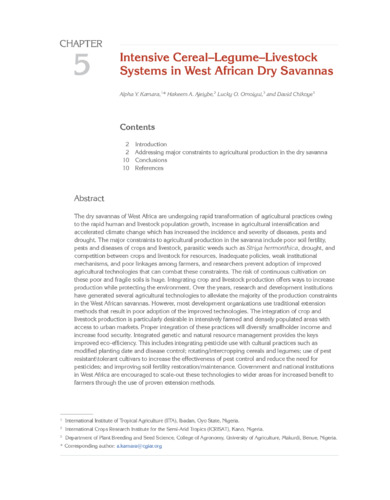Intensive cereal-legume–livestock systems in West African dry Savannas.
Abstract
The dry savannas of West Africa are undergoing rapid transformation of agricultural practices owing to the rapid human and livestock population growth, increase in agricultural intensification and accelerated climate change which has increased the incidence and severity of diseases, pests and drought. The major constraints to agricultural production in the savanna include poor soil fertility, pests and diseases of crops and livestock, parasitic weeds such as Striga hermonthica, drought, and
competition between crops and livestock for resources, Inadequate policies, weak institutional mechanisms, and poor linkages among farmers, and researchers prevent adoption of improved agricultural technologies that can combat these constraints. The risk of continuous cultivation on these poor and fragile soils is huge. Integrating crop and livestock production offers ways to increase production while protecting the environment. Over the years, research and development institutions have generated several agricultural technologies to alleviate the majority of the production constraints in the West African savannas. However, most development organizations use traditional extension methods that result in poor adoption of the improved technologies. The integration of crop and livestock production is particularly desirable in intensively farmed and densely populated areas with access to urban markets. Proper integration of these practices will diversify smallholder income and
increase food security. Integrated genetic and natural resource management provides the keys improved eco-efficiency. This includes integrating pesticide use with cultural practices such as modified planting date and disease control; rotating/ intercropping cereals and legumes; use of pest resistant\tolerant cultivars to increase the effectiveness of pest control and reduce the need for pesticides; and improving soil fertility restoration/maintenance. Government and national institutions
in West Africa are encouraged to scale-out these technologies to wider areas for increased benefit to farmers through the use of proven extension methods.

